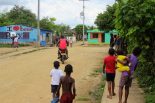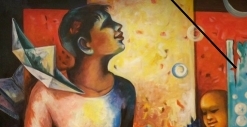Day 9
After a wonderfully warm and comfortable night in the ger, the morning brought with it a delicious breakfast of pancakes and tea. While others were packing, me and Oxanna went to say goodbye to the family. A Mongolian custom suggests that guests bring presents to their hosts, and so a small package of tea I brought from home served as our parting gift.

Loading a truck with our gear, and saddling our horses, we started our slow retreat from the Tsagaan Nuur reserve and towards our next hosting family. After a two-hour ride, we approached a bridge. Unloading our gear, we were told to wait on the other side.

Soon, a rugged, middle-aged man in a traditional Mongolian dress (called “del”) approached us and signaled to follow him. With our heavy bags on our backs we were escorted to a small house in the nearby village. A table laid with our lunch was already waiting for us.

As we later learned, this house was family’s winter place. Being half-nomads, they moved for the summer to the grasslands to graze their cattle and came back to their village for the winter. Finishing off the meal with the obligatory salted milk-tea, we were ready to move to the family’s summer place.

Loading our gear on one wooden cart, and sitting on another, we were taken by a pair of ominous-looking oxes out of the village, on our way to family’s ger. One of the oxes had an awful mad look, which possibly explained why his horns were broken.
With a young boy on a horse and our rugged-faced host on foot taking turns in leading the first ox, it was fascinating to see how these large beasts were effortlessly controlled. Pulling a leash connected to a nose ring (that pierces the soft part of the nose) was enough to encourage the bull to go where the handler was leading it. When the boy on the horse was leading the bulls, our host was sitting on the first cart and rhythmically beating the leading ox into cooperation.


Leaving the village behind, we were embraced by the great vastness of the surrounding grasslands. Lonely gers, small hordes of cattle and a myriad of low hills and valleys – this was our first taste of the Mongolian nomadic landscape. I loved it.

In Mongolia there is no concept of land-ownership outside of cities, so every family is free to roam the steppes and move freely from one place to another, in search of better grazing spots.

After a long ride we arrived at the family’s house an were immediately invited inside. The woman of the house served us milk tea and tsagaan idee – dairy products (literally “white food”). This included aaruul (white cheese curds) and a yellow substance, somewhere between sour cream and butter, served with bread.

After putting up our tents and begging our hosts for hujur (blankets) to put underneath the sleeping bags in our tents, we went to freshen up in the nearby river before the dinner.

The gathering clouds didn’t caught us unprepared this time. Out of the river and in our jackets, hats and raincoats, we were back at our camp, with enough time to make some photos of this incredible place.


The dinner was served in the family ger. We were getting used to large servings of noodles with meet. Trying to strike up a conversation with the family turned out to be a challenge – they didn’t know a word of either English or Russian, and our Mongolian was just enough to say hello and goodbye. What saved the evening was our hosts’ idea to let us churn cow milk in a large container.

During this process fat that is contained in milk accumulates on the top, is then collected, and turned into a buttery mass. The milky water is left to ferment, and when it’s ready, is distilled and turned into arkhi – light (15%) vodka (or rather wine) with a distinctive milk taste. Churning up the milk, we not only earned some good laughs but also were rewarded by glasses of arkhi. It turned to be quite tasty, with it’s milky flavor offsetting greatly its alcoholic body.
With a thermos of hot water back in my tent, this memorable day was coming to an end. Going over the day’s event’s, I have remembered our hosts’ rugged faces. With their oldest son being 18, the parents must have been in their forties (Mongolians merry in yearly twenties). But our host and his wife looked well over 60.

Apparently this hard climate of freezing winters and sun-burned summers leaves its mark on people’s faces.




It’s not the climate bro, it’s the fact that they are riding oxes, living in tents, and are medically stuck somewhere in the 18th century. I thought stories like this one could only exist in books
Bfw…I see you decided to display some unit pride with the tshirt. Very nice…how much
While they are poor by western standarts, and don’t have access to good
medical facilities, they are certainly not miserable. Their life isn’t easy,
but I bet that in overall they are not less happy than we in the west are
(if not more).
Stress, tension, depression that are so common in the west are uncommon
among nomads in Mongolia. The children grow up in a environment which gives
them enough freedom to develop self-confidence but also enough limits to
develop responsibility and sense of duty. So its common to see 10-year olds
riding horses and greasing cattle alone. This may explain the mental health
of Mongolians.
So, all in all, they are poor, but also happy and healthy people. I hope
that the coming decades will bring more prosperity to this poor country, as
it develops its touristic and mining potential.
It is very easy to criticize the western culture, because it is more advanced and thus more visible and vulnerable.
I know that if I had to live there and live their fun healthy life, greasing cattle and plowing fields, I would hate it.
You don’t become a 70 looking 40 year old, from happiness and health.
I’m not criticizing the western culture, I’m just saying that we have to
look at nomads’ life from a more balanced perspective. One that respects
their ethnic heritage, their national character, their ethos. Nowhere have I
met more proud and in the same time more relaxed and laid-back people. And
that must count for something.
Having said that, I obviously don’t suggest that it’s “good” that their
infrastructures, their medical and educational systems are hopelessly
outdated. There is much room for improvement of the life of common
Mongolians.
But what Mongolia needs from the world (the west, Russia, China) is
investments based on mutual gain, not charity.
reading this brings such great memories 🙂